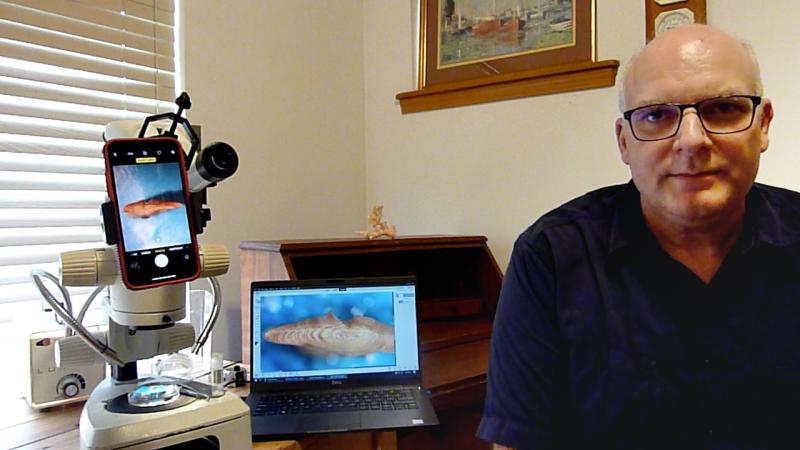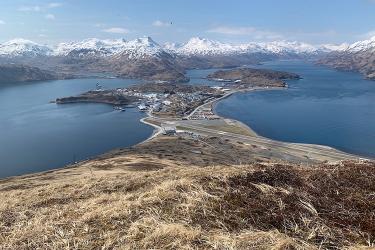Sometimes it’s a good thing to “take your work home with you.” A team of scientists at NOAA’s Alaska Fisheries Science Center is demonstrating that it is possible to accomplish a lot while teleworking. Their job is to study and estimate fish age, growth, and reproduction for a number of commercially important fish species from the Bering Sea, Gulf of Alaska and Aleutian Islands.
“One of our most important jobs at the Alaska Fisheries Science Center is estimating fish abundance and population trends (whether abundance is increasing or decreasing). A key piece of information used to generate that estimate is age data,” said Tom Helser, manager, Age and Growth Program. “Teleworking really hasn’t hindered staff productivity at all. They have aged nearly as many fish as they usually do in the laboratory, and they have found creative ways to do it.”
Some scientists have set up microscopes on their kitchen countertops and dining tables. Others are successfully using new mobile near-infrared technology to examine fish otoliths and ovaries. From this, they can estimate fish age and reproductive status.
Traditional Method of Ageing Fish
Otoliths are continually growing calcium carbonate structures. They are located in a fish’s inner ear and aid in hearing and balance. Fish otoliths form annual summer and winter bands, making them a useful tool to estimate fish age. They also absorb trace elements and isotopes of the surrounding water in which fish live, allowing scientists to learn about fish habitat preferences.
Scientists need a few key pieces of equipment to age an otolith. A microscope is essential. They also need tools to cut the otolith in half so they can examine the cross-section pattern. For small otoliths that are easy to cut through, like those found in Kamchatka flounder, they use a scalpel. For Pacific cod and pollock otoliths, which are bigger and thicker in size, they use a specialized saw. They also need a toaster oven. After sectioning, the otoliths are toasted so the growth zones become more prominent.
Charles Hutchinson toasting otoliths (32 secs). Video: NOAA Fisheries.
With the help of the microscope, scientists are able to see “growth zones,” deposited annually on the otolith. This tells them the age of the fish. The process is similar to determining the age of a tree. Scientists count tree rings to determine the tree’s life span; they count otolith growth zones to determine the age of a fish. In a normal year, the team ages more than 40,000 otoliths.
“Depending on the species I am looking at, I can usually age between 60-80 otoliths a day when I am at work. I’ve managed to achieve the same amount at home,” said Charles Hutchinson, age estimation analyst.
According to Delsa Anderl, who supervises this group of scientists, the team has successfully generated approximately 10,066 fish ages since starting telework in March.
“That is just slightly fewer than what we normally do in the laboratory for this time of year. The time needed to properly set up equipment at home reduced the time we had for age reading. One of our biggest challenges was distributing otoliths to the team.”
Safety and Efficiency in Conducting Age Research
Anderl has a simple but efficient system for both storing and safely transporting otoliths to all the analysts.
“What once was my daughter’s bedroom, then a makeshift pantry, now has become a storage room for boxes of otolith collections in my house. Dozens of otoliths boxes had to be temporarily moved from the laboratory. We did this to limit visits into NOAA campus buildings in Seattle and provide enough work for age readers while on mandatory telework.”
Initially 71 boxes containing the more than 10,000 otoliths were stacked up in the former bedroom. Over time, the number of boxes has dwindled to just a few.
Before distributing a box of otoliths, Anderl carefully wipes it down with alcohol. She then coordinates with staff to determine a meeting time and safe drop off point. Usually this is outside the front door of staff’s homes.
Innovative Approach to Validating Fish Age Estimates at Home
To validate the estimates and ensure that the age determination criteria have been applied consistently, two different analysts examine a subset of the otoliths. In the office, this is a rigorous, collaborative process.
However, when working remotely, the team had to find a way to collaborate without human contact. The analysts attach a cellphone to one of the dissecting microscope eyepieces. They then take a digital image of the dissected, baked otolith. Using Photoshop, they mark the growth zones on the image and then email the image to a colleague to validate their findings as Chris Gburski demonstrates in this short video.
Chris Gburski marking otolith growth zones in Photoshop (54 secs). Video: NOAA Fisheries.
Cameras on microscopes are important tools the Age and Growth program uses to document their work and the ageing criteria they use. Scientists are always developing new and better systems to accomplish their work. While teleworking they tested one of these new systems.
Because testing couldn't be done in person, IT and Data Manager, Jon Short and Anderl did the next best thing. They produced a short video for fellow analysts, so they would know how to set up and test the system.
Remote Testing for Mobile Near-Infrared Technology
Helser and his team have been spearheading a strategic initiative to advance the use of near-infrared technology agency wide. They are using Fourier Transform-Near Infrared Spectroscopy (FT-NIRS) to scan otoliths and examine the chemical compounds, in particular protein in the otolith. Younger fish have less protein in their otoliths than older fish.
With FT-NIRS technology, light from a special near-infrared source is focused on the otolith, which absorbs some light at characteristic wavelengths or frequencies. The amount of light that is absorbed is measured and recorded by an instrument called a spectrometer. Instead of counting growth rings, the age of the fish is revealed based on the amount of light absorbed and the amount of protein in the otolith.
This new technology could lead to big reductions in time, effort, and money spent on age and growth research. For instance, using the conventional method (microscope) to age a walleye pollock otolith, handling time per otolith is around 3–5 minutes, plus additional time for quality control readings. Using FT-NIRS technology the whole process takes 30–50 seconds per otolith—more than 10 times faster than traditional methods. Efficiency is likely to vary by species, but for walleye pollock, preliminary estimates indicate the new method can improve efficiency by 600 to 800 percent.
“We should be able to process otoliths more reliably and rapidly. The technology was in use for years in other industries, such as agriculture. It was viewed as a less invasive means to determine fat content in dairy products or protein content in animal feeds,” said Helser.
Two years ago, the Age and Growth Program at the Alaska Fisheries Science Center adapted the technology for use in fisheries science.
The latest innovation has been the development of a portable system. Helser hopes scientists will be able to use this system during research surveys to rapidly assess fish ages and to conduct other studies while at sea. His team demonstrated the effectiveness of the technology while teleworking.
“Next, we want to be able to pair the data generated through human analysis and the machine-based analysis to develop reliable, predictive models for studying fish development,” added Helser. “Jon (IT and Data Manager) has just developed a new database that integrates both data sets to help move us in this direction.”
Scientists on the team are using the technology to look at ovaries to study fish reproduction and liver and muscle tissue to examine fish condition.
“We have an important mission at the Alaska Fisheries Science Center to deliver the science needed to support healthy U.S. commercial and recreational fisheries, and coastal communities. Our scientists take this responsibility very seriously even when confronted with the challenges of working under less than ideal conditions,” said Robert Foy, Science and Research Director for the Alaska Fisheries Science Center.




